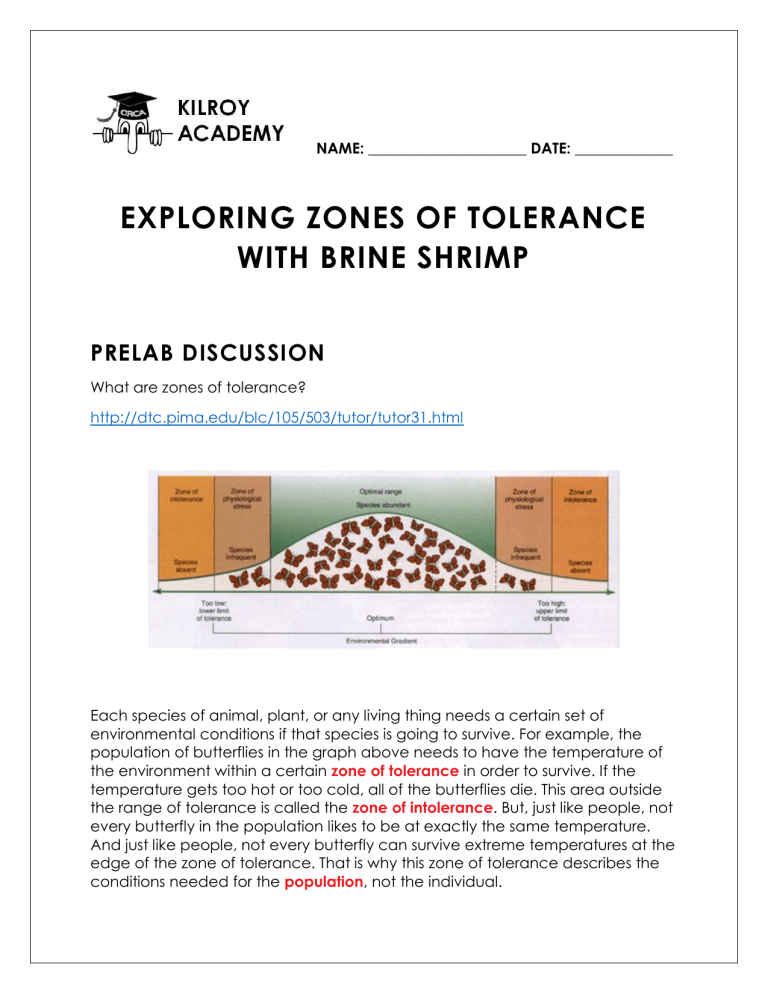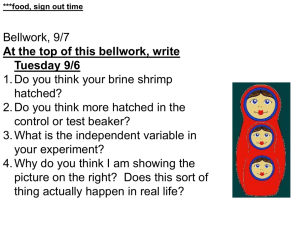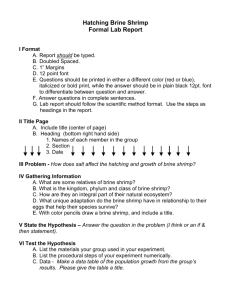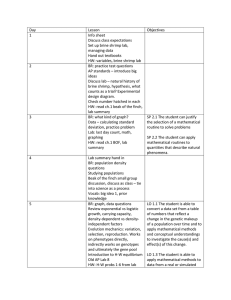
NAME: _____________________ DATE: _____________ EXPLORING ZONES OF TOLERANCE WITH BRINE SHRIMP PRELAB DISCUSSION What are zones of tolerance? http://dtc.pima.edu/blc/105/503/tutor/tutor31.html Each species of animal, plant, or any living thing needs a certain set of environmental conditions if that species is going to survive. For example, the population of butterflies in the graph above needs to have the temperature of the environment within a certain zone of tolerance in order to survive. If the temperature gets too hot or too cold, all of the butterflies die. This area outside the range of tolerance is called the zone of intolerance. But, just like people, not every butterfly in the population likes to be at exactly the same temperature. And just like people, not every butterfly can survive extreme temperatures at the edge of the zone of tolerance. That is why this zone of tolerance describes the conditions needed for the population, not the individual. In the middle of the zone of tolerance is the range where most of the butterflies are the most comfortable. This is the optimum range. As long as the temperature remains in this range, the population of butterflies will be healthy and reproductively successful. But look at what happens near the edges of the zone of tolerance. If the temperature starts to get just a little too hot or just a little too cold, some of the butterflies in the population die. Even the ones that survive will probably be under some physiological stress. So this is called the zone of physiological stress. You would feel the same way if your environment became too hot or too cold. For instance, if the temperature inside the biology lab dropped to 40 degrees Fahrenheit or climbed to 105 degrees Fahrenheit, very few students in lab would die, but most of the students would be feeling stressed! BRINE SHRIMP Brine Shrimp are tiny crustaceans that inhabit salty water around the world. As a matter of fact, the word “brine” means salt. Brine shrimp hatch from dormant eggs known as cysts. This has led to them being widely used in aquaculture. The cysts may be stored for long periods and hatched on demand to provide a convenient form of live feed for larval fish and crustaceans. The resilience of brine shrimp (aka: Artemia) makes them ideal animals for running biological toxicity assays and it is now one of the standard organisms for testing the toxicity of chemicals. A breed of brine shrimp is sold as a novelty gift under the marketing name “sea monkeys”. In this lab you will be testing the impact of salinity on brine shrimp egg hatching. You will be using five different concentrations of salt water (2%, 4%, 6%, 8%, 10%) to determine which one hatches the most shrimp. I recommend that you make your salt solutions using “Instant Ocean” (or some alternative to it) and distilled water. In a class setting, each lab group should be assigned a differ concentration of water to test. This way each concentration is tested four times. Please use what you know about the scientific method to fill in the lab sheet below. ***Teacher Notes: Make sure that you have recently purchased shrimp eggs. Older ones are less likely to hatch than newer ones. If there are too many brine shrimp to count in each dish, you may use a “swirl and suck” sampling method to gain a random sample of hatchlings. This method works by having students empty the contents of the dish into a small beaker. The student is then to take a pipette and swirl the solution then suck one pipette full out of the container. Then they can place the contents of the pipette into a smaller petri dish for counting purposes. PRELAB QUESTIONS 1. What is a zone of tolerance? 2. Why do zones of tolerance describe populations and not individuals? 3. Contrast the optimum range with the zone of physiological stress. 4. What is your optimum range for temperature? 5. Why are brine shrimp widely used in aquaculture? 6. Why should we use distilled water instead of tap water for this lab? BRINE SHRIMP LAB Problem: What percentage (%) of salt water produces the greatest number of brine shrimp hatchlings? Hypothesis: The ___________ % of salt water will produce the greatest number of brine shrimp hatchlings. ( 2%, 4%, 6%, 8%, 10%) Insert what you think will be best. Variables: Fill in each variable: Dependent Variable: Independent Variable: Standardized Variables: Control: MATERIALS: 4 petri dishes Brine shrimp eggs Masking tape Marker Graduated Cylinder % salt solutions Distilled water Dissecting Microscope Small plastic cups Flat toothpicks PROCEDURES: 1. Label each petri dish -name, period, and % solution assigned to your group. (Do this on a piece of tape you attach to the dish!) 2. Place 20 mL’s of your assigned solution in each dish. 3. Place a small amount of brine shrimp eggs in each dish – about the amount that would fit on the tip of the flat toothpick. 4. Stack all the petri dishes on top of one another and tape them together. 5. Bring them to the teacher to place in the incubator. 6. After 6 days look at your dish under the dissecting microscope and record the number of FULL hatchlings (dead or alive). a: Make a data table: Use class data. Percent salt solutions #hatchlings 0% 1 2 3 4 2% 4% 6% 8% 10% Results: You will be analyzing your data and explaining in words what happened, make a graph to show class averages for each salt solution. Conclusion: Agree or disagree with your hypothesis. TELL WHY! ADDITIONAL RESOURCES Why Monitor Our Waters This resource explains why it is crucial to monitor our water to help assure that environmental factors stay within a range that will optimize survival. http://www.teamorca.org/cfiles/why_monitor.cfm ACKNOWLEDGEMENTS Thank you to Katie Hulse, Biology Teacher at Vero Beach High School, for creating this activity and worksheet. Special thanks to Indian River Impact 100 for funding Kilroy Academy. Made possible with funding provided by . © 2014 Kilroy Academy





